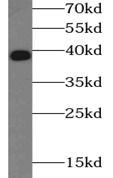Products
IkB alpha antibody
Category:
Research Area:
| Synonyms: | I kappa B alpha antibody, IkappaBalpha antibody, IkB alpha antibody, IKBA antibody, Ikβ-α antibody, MAD 3 antibody, MAD3 antibody, NF kappa B inhibitor alpha antibody, NFKBI antibody, NFKBIA antibody | ||
| Catalogue No.: | FNab04196 | Reactivity: | Human, Mouse, Rat, Pig |
| Host: | Rabbit | Tested Application: | ELISA, IHC, IF, WB, IP, FC |
| Clonality: | polyclonal | Isotype: | IgG |
- SPECIFICATIONS
- Product Name
- IkB alpha antibody
- Catalogue No.
- FNab04196
- Size
- 100μg
- Form
- liquid
- Purification
- Immunogen affinity purified
- Purity
- ≥95% as determined by SDS-PAGE
- Clonality
- polyclonal
- Isotype
- IgG
- Storage
- PBS with 0.02% sodium azide and 50% glycerol pH 7.3, -20℃ for 12 months(Avoid repeated freeze / thaw cycles.)
Immunogen
- Immunogen
- nuclear factor of kappa light polypeptide gene enhancer in B-cells inhibitor, alpha
- Alternative Names
- I kappa B alpha antibody, IkappaBalpha antibody, IkB alpha antibody, IKBA antibody, Ikβ-α antibody, MAD 3 antibody, MAD3 antibody, NF kappa B inhibitor alpha antibody, NFKBI antibody, NFKBIA antibody
- UniProt ID
- P25963
- Observed MW
- 39 kDa
Application
- Tested Applications
- ELISA, IHC, IF, WB, IP, FC
- Recommended dilution
- WB: 1:500-1:2000; IP: 1:500-1:2000; IHC: 1:50-1:500; IF: 1:50-1:500
Validated Images
 HL-60 cells were subjected to SDS PAGE followed by western blot with FNab04196(NFKBIA antibody) at dilution of 1:500
HL-60 cells were subjected to SDS PAGE followed by western blot with FNab04196(NFKBIA antibody) at dilution of 1:500
 IP Result of anti-IkB alpha (IP:FNab04196, 4ug; Detection:FNab04196 1:1000) with HeLa cells lysate 4000ug.
IP Result of anti-IkB alpha (IP:FNab04196, 4ug; Detection:FNab04196 1:1000) with HeLa cells lysate 4000ug.
 Immunohistochemistry of paraffin-embedded human kidney tissue slide using FNab04196(NFKBIA Antibody) at dilution of 1:200
Immunohistochemistry of paraffin-embedded human kidney tissue slide using FNab04196(NFKBIA Antibody) at dilution of 1:200
 Immunofluorescent analysis of ( -20℃ Ethanol ) fixed HeLa cells using FNab04196(NFKBIA Antibody) at dilution of 1:50 and Alexa Fluor 488-conjugated Goat Anti-Rabbit IgG(H+L)
Immunofluorescent analysis of ( -20℃ Ethanol ) fixed HeLa cells using FNab04196(NFKBIA Antibody) at dilution of 1:50 and Alexa Fluor 488-conjugated Goat Anti-Rabbit IgG(H+L)
- Background
- This gene encodes a member of the NF-kappa-B inhibitor family, which contain multiple ankrin repeat domains. The encoded protein interacts with REL dimers to inhibit NF-kappa-B/REL complexes which are involved in inflammatory responses. The encoded protein moves between the cytoplasm and the nucleus via a nuclear localization signal and CRM1-mediated nuclear export. Mutations in this gene have been found in ectodermal dysplasia anhidrotic with T-cell immunodeficiency autosomal dominant disease.



